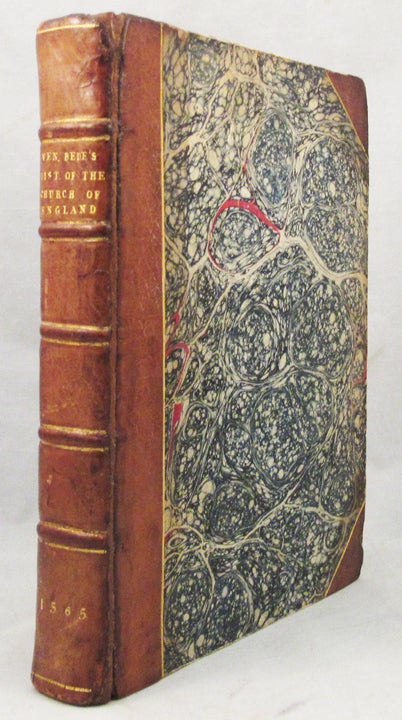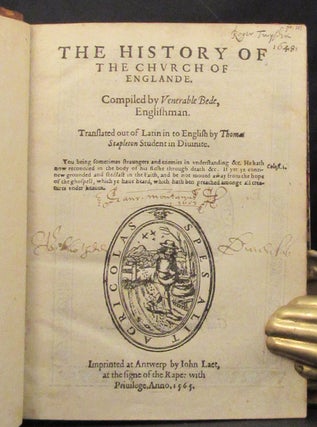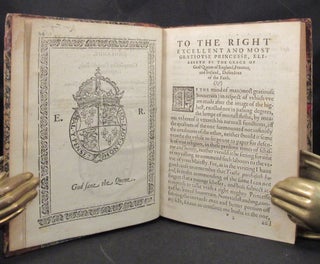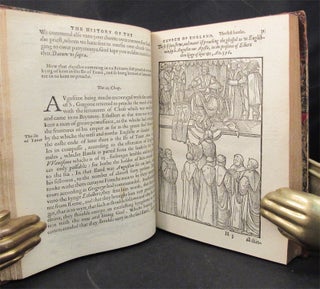THE HISTORY OF THE CHURCH OF ENGLANDE COMPILED BY VENERABLE BEDE, Englishman. Translated Out of the Latin to English by Thomas Stapleton Student in Diuninite.
(Antwerp: John Laet, 1565).
VERY RARE FIRST EDITION IN ENGLISH OF THE FIRST AND GREATEST WORK OF ENGLISH HISTORY BY THE FATHER OF ENGLISH HISTORY. RARE IN COMPLETE STATE, when one reads the catalogue entries of copies in even some of the worlds most prestigious institutions one finds descriptions of missing signatures, facsimile titles, or entire sections excised to be quite the norm. This copy, but for its probable early 19th century blank flies and endpapers is wholly intact and in a truly exceptional state of preservation.
The Venerable Bede's title of "The Father of English History" is well deserved. He was England’s greatest historian in the Middle Ages. His greatest work is the Historia Ecclesiastica, here in its first English edition. It is an ecclesiastical history of the English people. Bede begins with Caesar’s invasion in 55 BCE and St. Alban’s martyrdom in Roman Britain, tracks the spread of Christianity following St. Augustine’s mission to England in 597, and provides an account of critical events such as the Council of Whitby, which decided that Roman rather than Celtic Christian customs would be followed in Britain.
Bede drew on the many manuscripts in the Jarrow monastery’s outstanding library and correspondents provided him materials. He was a diligent scholar and properly credited his sources. To the benefit of historical scholarship, Historia Ecclesiastica spread widely throughout Europe in the Middle Ages, with some 160 manuscripts still surviving. Not long after his death, he became known as the Venerable Bede. His was one of the first printed history books, published (in Latin) in Strasbourg about 1475. Highly popular on the Continent and in Britain, it was reprinted in 1500, 1506, and 1514.
Due to its strong association with Catholicism this first translation into the English tongue was published in Antwerp, as the book was then prohibited in England as traitorous. Stapleton was educated in Oxford, where he became a fellow in 1553. On Queen Elizabeth’s accession, he left England to study theology in Louvain and Paris. His translation of Bede was his first of many fine works. Stapleton used Bede’s history to remind the reader that “we Englishmen also these many hundred of years kept and preserved sound and whole the precious perle of right faith and belefe,” and he admonished that “after we forsooke the first paterne off the Christen faith delievered to us, we have fallen in to plenty of heresies.” He added that the Venerable Bede, a most reliable source, describes many miracles that occurred in Britain under the true faith. Stapleton's translation has been called an "enduring contribution to this sparkling collection of [recusant] prose" -DNB)
This is also a copy of fine and established provenience. It was formerly owned by the renown historian and antiquary Roger Twysden, whose ownership signature is dated 1648. Having been caught up in civil war strife, Twysden retired to his seat, Roydon Hall, and devoted himself to his study and writings, particularly on early English histories and monasticism. His collection passed to Sir John Sebright, who sold the main portion at auction in 1807. Much of Twysden's collection later passed to Sir John Sebright, whose fine engraved armorial plate is afixed to the front paste-down. The present binding was likely made while the book was in Sebright's possession.
Contrary to the implications of Stapleton's edition of Bede, Twysden's Historical vindication of the Church of England (1657) argued that it was the Church of England, rather than Rome, which had held fast to the true faith, and that the pope's powers over England, gained gradually over the centuries, had been submitted to voluntarily out of love not duty, for the archbishop of Canterbury had no mediate superior but only Christ and God (see Jessup, Sir Roger Twysden pp. 192-5). Completed in 731, Bede's Historia ecclesiastica gentis Anglorum, is 'probably one of the most popular history books in any language and has certainly retained it popularity longer than any rival. The enthusiasm shown for his writings in the eighth century by English missionaries on the Continent, such as Boniface, Lul, and others, led to the spread of knowledge of his works not only in England but also in western Europe . . . . From then on, as the spread of his manuscripts shows, the History became popular all over western Europe and 160 of them survive today in spite of all the wars and other dangers to which manuscripts are always subject' (Colgrave & Mynors p. xvii). It was first printed c. 1475, at Strasbourg (PMM 16). 'Bede provided for over a thousand years, and to a large extent still provides, nearly all the knowledge available of the early history of England. His Historia is the only work, other than parts of the Bible, which has been read by every English generation from his own day to the present. It has the power to move and to convey something of the personality of its author, to a degree which has called forth not only admiration but a kind of affection' (Oxford DNB). Item #32099
Five books in one volume. A VERY RARE COMPLETE COPY, the First Edition of Historia ecclesiastica gentis Anglorum translated into English. Provenance: Montanus, 1602 -- Sir Roger Twysden, 1648, and Sir John Saunders Sebright (armorial bookplate). With woodcut device on titlepage, woodcut armorial dedication to Queen Elizabeth, woodcut plate of St. Augustin with Elbert King of Kent in anno 596, woodcut plate of King Oswald uniting the Umbrian kingdoms, halfpage woodcut of Elbert building St. Paul's, and with many large and handsome woodcut initials all throughout. The woodcuts are possibly by Arnaud Nicolai. Small 4to (188 x 140 mm), in antique three-quarter russia over marbled boards, the spine with raised bands ruled in gilt, one compartment gilt lettered, gilt dating at the tail, gilt lined back and cornerpieces. *1-6, >1-4, #1-4, 192, [9] pp. A truly excellent survival of a book rarely found complete. The text-block is especially fresh and well preserved, crisp and very clean. The blanks date from the time of the binding, but the text is otherwise wholly complete and original, the binding is handsome though its age is evident and there was restoration some time ago to the hinges, the front of which is also strengthened from within.



